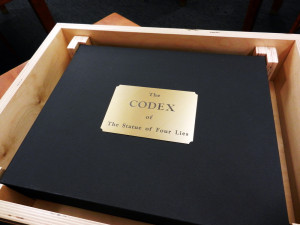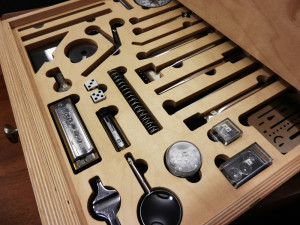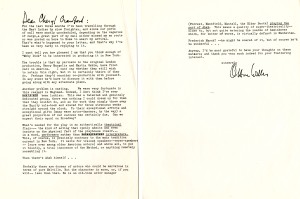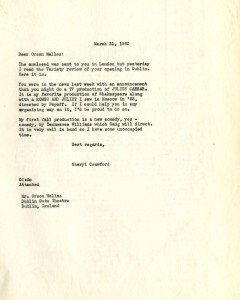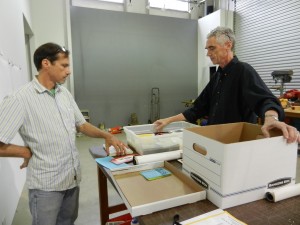
Here at Special Collections, we just love The Art Guys. That is, we love them until they start to hurt our brains by making us think.
Since 2010, when “The Statue of Four Lies” was added to the hundreds of other pieces of art that adorn our fine campus, a certain rite of passage seems to have been established. Each fall semester, green undergraduate freshmen stumble by the piece, full of double takes and perplexed head scratching. In time, they transform into jaundiced sophomores who long ago gave up trying to apply meaning to the statue and, instead, have retreated back into their academia in hopes of finding meaning. Now, almost four years later, the occasional graduate student still stroll by with a scoff and roll of her eyes at those who continue to stand next to the statue in bewilderment.
Over these years the public has not been at a loss of ideas and theories as to “what it all means,” anyway and countless theories have surfaced. Some argue it is a treatise on the nature of truth vs. Truth. Others will put forward the theory that the statue is a critique on the ubiquitous and acceptable nature of lies as the basis of our day-to-day existence. Here in Special Collections, of course, we knew all along that the statue was really… well…
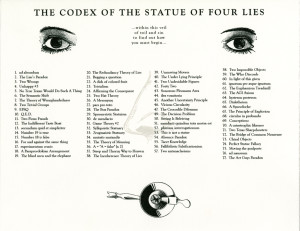 We don’t want to ruin it for you.
We don’t want to ruin it for you.
However, the loyal Cougars that they are, The Art Guys made sure to house the Codex of the Statue of Four Lies here in Special Collections. Particularly observant visitors to the statue’s website will note in the fine print that the, “CODEX SPECIALIBUS IN COLLECTIONIBUS BIBLIOTHECAE INVENITUR.” So, don’t you want all the answers? Don’t you want to know what it all means? Just take a trip up to the second floor of the M.D. Anderson Library and ask to see the Codex Specialibus to have the Truth truth revealed.
Or, is that a lie?
Knowing The Art Guys and their proclivity for playfulness and ambiguity, you may walk away with more questions and, really, is that such a bad thing?
As noted recently on NPR, today marks the 125th anniversary of the publication of the classic baseball poem, “Casey at the Bat,” in 1888. One of our patrons heard the piece on the radio, and while visiting us in the Reading Room for some other research, asked if we might happen to have any materials related to this poem. A discussion ensued, and while we do not have any direct connection, a challenge was thrown down: Could we find a connection from “Casey at the Bat” to something in our archives in six steps, a la “Six Degrees of Separation”?
Well, here we go:
1. “Casey at the Bat” was written by Ernest Thayer.
2. Ernest Thayer was friends with William Randolph Hearst from their days together at the Harvard Lampoon – and Hearst later hired Thayer as humor columnist for the San Francisco Examiner, which first published “Casey” in 1888.
3. William Randolph Hearst was the inspiration for the renowned film Citizen Kane, directed by and starring Orson Welles.
4. Orson Welles exchanged correspondence with theater producer/director Cheryl Crawford; this correspondence is available right here in our archives among the Cheryl Crawford Papers.
Six degrees? Ha! We got there in four. So although there might be “no joy in Mudville,” as “mighty Casey has struck out,” we are feeling a bit victorious here in Special Collections today.
Interested researchers and visitors may view these letters and much more in our Reading Room. The bulk of the Cheryl Crawford Papers dates from 1940-1978, documenting Ms. Crawford’s career in theater through correspondence, production materials, scripts, programs, playbills, audio tapes, posters, sheet music, sound recordings, clippings, budgets, tax returns, legal agreements, contracts, audits, reviews, speeches, and miscellaneous items such as postcards and receipts.
Special Collections is delighted to announce that it has recently acquired the records of The Art Guys, a Houston-based art duo. The Art Guys (Jack Massing and Michael Galbreth) work in a variety of media, including performance art, drawing, installation, and video. The records accessioned by Special Collections date from the 1980s to present and include the Art Guys’ business records, publicity material, and exhibition invitations.
The Art Guys met at the University of Houston in 1983 and have been collaborating ever since. Their work has been featured in more than 150 exhibitions throughout the United States and the world. On their biography, the Art Guys state that they “use humor and everyday materials as a way to demystify art in an attempt to welcome a broad range of audiences into the discourse of contemporary art.”
In 2013, The Art Guys have a year of celebration planned for their 30th year working together, so check out the events they have listed for their monthly 12 Events series! Meanwhile, archivists will be hard at work on making the Art Guys Records available for research, so keep an eye out for further news from Special Collections.
